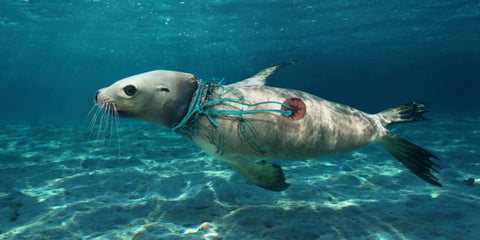There's nothing supernatural about ghost nets, but they're still spooky. A ghost net is a fishing net lost or abandoned in the ocean. They are one of the key elements of the global problem of " ghost fishing" , which concerns fishing equipment abandoned at sea. Because while we are enjoying the beaches with our pretty sustainable swimsuits, abandoned fishing nets or lines in the ocean threaten marine life.

The damage caused by ghostfishing
It is not because a net is no longer used by fishermen that it no longer works. These nets continue to trap everything in their path, posing a major problem for the health of our oceans and marine life. Ghost nets don't just catch fish; they also entangle sea turtles, dolphins, birds, sharks, seals, etc. These animals get caught in these nets, often unable to detect them by sight or sonar.
The nets prevent animals from moving freely, cause injuries and prevent mammals and birds from coming to the surface to breathe. Considering that hundreds of animals can be caught in a single net, it's not hard to see how big of a threat this threat is. And ghost nets also damage coral reefs - breaking corals, exposing them to disease and even robbing reefs of precious sunlight.
Ghost nets are also a major contributor to the ocean plastics crisis. Most modern nets are made of nylon or other plastic compounds that can last for centuries. According to a 2018 study published in Scientific Reports , ghost nets make up at least 46% of the North Pacific Garbage Patch . These abandoned fishing lines and nets break but never disappear; they just become smaller pieces of plastic. Marine animals mistake these microplastics for food and eat them, which can hamper their internal organs, preventing them from eating and exposing them to toxic chemicals.
So when you're on the beach with your pretty eco-responsible swimsuit, know that during this time ghostfishing is wreaking havoc underwater.
Solutions to combat ghostfishing
Although there is no quick fix, the United Nations has offered practical measures to limit ghostfishing. These measures include educating the fishing industry on the problem of ghostfishing, encouraging fishermen to report lost gear and retrieving nets they find at sea. Setting up collection facilities in each port would also help anglers quickly and safely store damaged or salvaged old gear, ready to be recycled into new items. As we do for ethical swimwear.
Technology also aids in the tracking and recovery of lost equipment. Transponders can be fitted to fishing gear and GPS used to mark the precise location where it has been lost. Imagery of the ocean floor helps ships avoid underwater snags, while state-of-the-art weather monitoring equipment helps steer clear of rough seas. Similarly, there are also innovative solutions such as biodegradable fish traps that incorporate an “escape hatch” that dissolves when left in water for too long. So many solutions that can help fight against leghostfishing.



